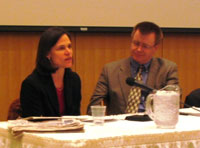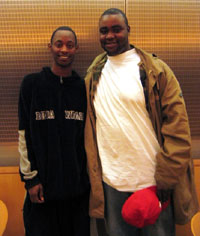On Their Own: Why Do Kids Become Homeless? (web article)
Why Do Kids Become Homeless?
On any day of the year, 10,000 Maryland youth are in foster or group homes, about 7,000 of them from Baltimore City. Another 3,000 Baltimore City students are homeless, most having left their homes because of family conflicts, absentee parents, physical or sexual abuse, or a history of multiple out-of-home placements.
These are some of the stark facts that came out at a December 12 symposium at the Johns Hopkins Bloomberg School of Public Health called, “Iven and Gary: Can We Do More for Baltimore's Unstably Housed Youth?"

Liz Bowie and Matthew Stagner
Photo credit: Christine Verdon
Iven and Gary (who were in the audience at the symposium) were the subjects of a four-part series of newspaper articles by Baltimore Sun reporter Liz Bowie. Called “On Their Own,” this extended piece appeared in October and chronicled the experiences of the two homeless Baltimore City teens as they struggled against herculean odds to keep afloat and graduate from high school. Bowie, who worked on “On Their Own” for about a year, was one of the panelists at the symposium.
Why would nearly 3,000 Baltimore high schoolers live on the streets rather than go to Social Services for help? Said Bowie, “They guard their poverty and homelessness no matter what. They don’t want to confide in adults who might turn them into Social Services. Foster care or a group home represents the unknown, and it’s better to be on your own than to be yanked away from your friends and neighborhood.”
Two things surprised Bowie as she worked with Iven and Gary. “I was amazed at the effect of drugs and addiction in this city—almost everybody in their families has been touched by this scourge. “ She was also moved by how hard both Iven and Gary had to struggle to keep away from their families, “even though each knew the worst thing for them [at this point] would be to stay close to some family members.”

Iven and Gary at the symposium
Photo credit: Christine Verdon
Bowie is often asked if reporting the story was depressing. “It wasn’t sad,” she said. “These guys are incredibly fun to be with. They were upbeat and very much like my own children, except for their circumstances.” And Iven and Gary themselves? Bowie told the audience that Iven is at Allegheny College in Cumberland, Md., “doing pretty well,” and that Gary took a maintenance position six weeks ago with a parking lot company and is much happier than with his previous job.
Matthew Stagner, PhD, director of the Center on Labor, Human Services and Population at the Urban Institute, said that he is most concerned about the child welfare system’s failure to help young people make the transition from teen to adult. “Adolescence is supposed to be a journey from childhood to adulthood,” said Stagner, “and usually it’s a very gradual journey. But our policymakers treat this section of the life span as an either/or thing. How can we better prepare homeless teenagers for adulthood, and not just lead them up to the doorway and push them through?”
Ross Pologe, executive director of Fellowship of Lights, a nonprofit organization that has been helping runaway children in Baltimore in 1970, said the increase in teen homelessness could be explained by simple mathematics: “Say the rent for a one-bedroom efficiency apartment is $750 a month. A person with a minimum-wage job would have to work 100 hours a week just to pay that rent—and that’s not counting utilities, food and health care.”
Pologe then posed a rhetorical question. “Imagine if the children of privilege, instead of going to college, were suddenly thrust out at 18 with a minimum-wage job and told to fend for themselves. These are kids, remember, who often return home for awhile after college, to get their feet on the ground.”
Samuel Chambers Jr., the director of the Baltimore City Department of Social Services, said that too-strict regulations were handcuffing the agencies that work with youths. Chambers, who came to Baltimore a year ago after 37 years in the field, mostly in Detroit, said his agency has been exploring ways to cut red tape and become more flexible. “We need to look at these regulations and challenge the officials to waive certain housing requirements that right now are standing in the way of helping these kids. We need a continuum of housing options and we need alternatives to the public school system.”
“What can we learn from [“On Their Own”]?” asked Chambers. “I’m frightened because we are not a learning society. I’m scared we won’t learn from it. I’m scared that we will continue to lose kids.”
The panelists agreed that youths are certainly not being served when government agencies, churches and community groups all hunker down in their own cozy “silos,” avoid talking with each other and expect kids to come to their offices.
Ross Pologe said, “After ‘On Their Own’ came out, I got notes from people in the outlying suburbs saying in effect, ‘Poor Baltimore!’ But let’s not fool ourselves. This problem is everywhere. This is not an issue of race or class; everywhere in the U.S., children are disposable.” —Rod Graham
Three centers at the Bloomberg School—the Center for Adolescent Health, the Center for the Prevention of Youth Violence, and the Center for Injury Research and Policy—organized the symposium to build on the energy generated by Liz Bowie’s "On Their Own.”
